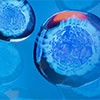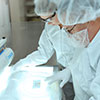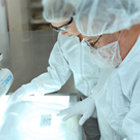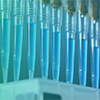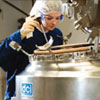Antilichamen
Itemnummer:
(BOSSBS-8614R-A488)
Leverancier:
Bioss
Omschrijving:
In budding yeast, the Cdc14a phosphatase activates mitotic exit by dephosphorylation of specific cyclin-dependent kinase (Cdk) substrates and seems to be regulated by sequestration in the nucleolus until its release during mitosis. Human Cdc14a phosphatase is highly similar to Saccharomyces cerevisiae Cdc14 and is a member of the dual specificity protein Tyrosine phosphatase family. It interacts with and dephosphorylates tumor suppressor protein p53 and may regulate the function of p53. In addition, Cdc14a dephosphorylates hCdh1 and activates APCCdh1. Cdc14a phosphatase plays a role in the regulation of the centrosome cycle, mitosis and cytokinesis, thereby influencing chromosome partitioning and genomic stability in human cells. Deregulated human Cdc14a phosphatase disrupts centrosome separation and chromosome segregation.
UOM:
1 * 100 µl
Itemnummer:
(BOSSBS-8615R-A647)
Leverancier:
Bioss
Omschrijving:
Cytotoxin and helminthotoxin with low-efficiency ribonuclease activity. Possesses a wide variety of biological activities. Exhibits antibacterial activity, including cytoplasmic membrane depolarization of preferentially Gram-negative, but also Gram-positive strains. Promotes E.coli outer membrane detachment, alteration of the overall cell shape and partial loss of cell content.
UOM:
1 * 100 µl
Itemnummer:
(BOSSBS-9016R-FITC)
Leverancier:
Bioss
Omschrijving:
Members of the EF-CBP (N-terminal EF-hand calcium binding protein)/NECAB (neuronal calcium-binding protein) family participate in neuronal calcium signaling. EF-CBP2, also known as NECAB2 (N-terminal EF-hand calcium binding protein 2), neuronal calcium-binding protein 2 or synaptotagmin-interacting protein 2 (Stip-2), is a 386 amino acid cytoplasmic protein that contains one antibiotic biosynthesis monooxygenase (ABM) domain and two EF-hand domains. Expressed in brain, EF-CBP2 is suggested to bind metabotropic glutamate receptor 5 (mGluR-5) in a calcium-regulated manner. The gene encoding EF-CBP2 maps to human chromosome 16, which encodes over 900 genes and comprises nearly 3% of the human genome. The rare disorder Rubinstein-Taybi syndrome is also associated with chromosome 16, as is Crohn's disease, which is a gastrointestinal inflammatory condition.
UOM:
1 * 100 µl
Itemnummer:
(BOSSBS-5422R-CY3)
Leverancier:
Bioss
Omschrijving:
Protein phosphatase 1 (PP1) is essential for cell division, and participates in the regulation of glycogen metabolism, muscle contractility and protein synthesis. The protein is involved in regulation of ionic conductances and long term synaptic plasticity. It may play an important role in dephosphorylating substrates such as the postsynaptic density associated Ca (2+)/calmodulin dependent protein kinase II.PP1 comprises a catalytic subunit, PPP1CA, PPP1CB or PPP1CC (PP1C gamma), which is folded into its native form by inhibitor 2 and glycogen synthetase kinase 3, and then complexed to one or several targeting or regulatory subunits. PPP1R12A and PPP1R12B mediate binding to myosin. PPP1R3A, PPP1R3B, PPP1R3C and PPP1R3D mediate binding to glycogen.
UOM:
1 * 100 µl
Itemnummer:
(BOSSBS-5422R-CY7)
Leverancier:
Bioss
Omschrijving:
Protein phosphatase 1 (PP1) is essential for cell division, and participates in the regulation of glycogen metabolism, muscle contractility and protein synthesis. The protein is involved in regulation of ionic conductances and long term synaptic plasticity. It may play an important role in dephosphorylating substrates such as the postsynaptic density associated Ca (2+)/calmodulin dependent protein kinase II.PP1 comprises a catalytic subunit, PPP1CA, PPP1CB or PPP1CC (PP1C gamma), which is folded into its native form by inhibitor 2 and glycogen synthetase kinase 3, and then complexed to one or several targeting or regulatory subunits. PPP1R12A and PPP1R12B mediate binding to myosin. PPP1R3A, PPP1R3B, PPP1R3C and PPP1R3D mediate binding to glycogen.
UOM:
1 * 100 µl
Itemnummer:
(BOSSBS-12417R-A555)
Leverancier:
Bioss
Omschrijving:
Transmembrane serine/threonine kinase activin type-2 receptor forming an activin receptor complex with activin type-1 serine/threonine kinase receptors (ACVR1, ACVR1B or ACVR1c). Transduces the activin signal from the cell surface to the cytoplasm and is thus regulating many physiological and pathological processes including neuronal differentiation and neuronal survival, hair follicle development and cycling, FSH production by the pituitary gland, wound healing, extracellular matrix production, immunosuppression and carcinogenesis. Activin is also thought to have a paracrine or autocrine role in follicular development in the ovary. Within the receptor complex, the type-2 receptors act as a primary activin receptors (binds activin-A/INHBA, activin-B/INHBB as well as inhibin-A/INHA-INHBA). The type-1 receptors like ACVR1B act as downstream transducers of activin signals. Activin binds to type-2 receptor at the plasma membrane and activates its serine-threonine kinase. The activated receptor type-2 then phosphorylates and activates the type-1 receptor. Once activated, the type-1 receptor binds and phosphorylates the SMAD proteins SMAD2 and SMAD3, on serine residues of the C-terminal tail. Soon after their association with the activin receptor and subsequent phosphorylation, SMAD2 and SMAD3 are released into the cytoplasm where they interact with the common partner SMAD4. This SMAD complex translocates into the nucleus where it mediates activin-induced transcription. Inhibitory SMAD7, which is recruited to ACVR1B through FKBP1A, can prevent the association of SMAD2 and SMAD3 with the activin receptor complex, thereby blocking the activin signal. Activin signal transduction is also antagonized by the binding to the receptor of inhibin-B via the IGSF1 inhibin coreceptor.
UOM:
1 * 100 µl
Itemnummer:
(BOSSBS-11282R-CY7)
Leverancier:
Bioss
Omschrijving:
EVC is an autosomal skeletal dysplasia caused by mutations in the EVC and EVC2 genes. Found in developing ribs, heart, kidney and lung, the EVC gene is responsible for normal development of the face, limbs, teeth and nails. The protein expressed by the EVC gene is an intracellular component of the hedgehog signal pathway that contains a leucine zipper and transmembrane domain. Defects in the EVC gene can lead to short-limb dwarfism, ectodermal dysplasia and cardiac anomalies such as irregular atrioventricular septum development. Additionally, the EVC gene has been implicated in Weyers acrodental dysostosis, an autosomal dominant disease characterized by facial abnormalities and limb defects.
UOM:
1 * 100 µl
Itemnummer:
(BOSSBS-3608R-CY5.5)
Leverancier:
Bioss
Omschrijving:
This gene encodes a member of the cytochrome P450 superfamily of enzymes. The cytochrome P450 proteins are monooxygenases which catalyze many reactions involved in drug metabolism and synthesis of cholesterol, steroids and other lipids. This protein localizes to the mitochondrial inner membrane and catalyzes the conversion of cholesterol to pregnenolone, the first and rate-limiting step in the synthesis of the steroid hormones. Two transcript variants encoding different isoforms have been found for this gene. The cellular location of the smaller isoform is unclear since it lacks the mitochondrial-targeting transit peptide. [provided by RefSeq, Jul 2008]
UOM:
1 * 100 µl
Itemnummer:
(BOSSBS-9289R-A350)
Leverancier:
Bioss
Omschrijving:
The deduced 257 amino acid protein PACRG (Parkin co-regulated gene) shows potential links to the ubiquitin/proteasome system. PACRG and Parkin are attached in a head-to-head arrangement on opposite DNA strands and share a common 5' flanking promoter region. The PACRG gene maps to chromosome 6q26; Northern blot analysis detects PACRG expression in all tissues examined except placenta. Using a positional cloning strategy in 197 Vietnamese leprosy simplex families (i.e. families with two unaffected parents and one affected child), significant connections between leprosy and 17 markers in the 5' regulatory region that PARK2 and PACRG share were observed. Possession of two or more of the 17 risk alleles is highly predictive of leprosy.PACRG is a gene located very close to parkin, in reverse orientation on the chromosome. It is thought to be co-transcribed with parkin by a bi-directional promoter between the two genes.
UOM:
1 * 100 µl
Itemnummer:
(BOSSBS-15098R-A555)
Leverancier:
Bioss
Omschrijving:
Representing about 2% of human DNA, chromosome 20 consists of approximately 63 million bases and 600 genes. Chromosome 20 contains a region with numerous genes expressed in the epididymis, which are thought important for seminal production, and some viewed as potential targets for male contraception. The PRNP gene encoding the prion protein associated with spongiform encephalopathies, like Creutzfeldt-Jakob disease, is found on chromosome 20. Amyotrophic lateral sclerosis, spinal muscular atrophy, ring chromosome 20 epilepsy syndrome and Alagille syndrome are also associated with chromosome 20. The C20orf165 gene product has been provisionally designated C20orf165 pending further characterization.
UOM:
1 * 100 µl
Itemnummer:
(BOSSBS-1099R-A350)
Leverancier:
Bioss
Omschrijving:
Calcium-regulated non-lysosomal thiol-protease which catalyze limited proteolysis of substrates involved in cytoskeletal remodeling and signal transduction.
UOM:
1 * 100 µl
Itemnummer:
(BOSSBS-3284R-A350)
Leverancier:
Bioss
Omschrijving:
MSK1 is a mitogen and stress activated protein kinase 1 which belongs to the AGC family of kinases and is related in structure to the ribosomal p70 S6 kinase subfamily. MSK1 can be activated by ERK1/2 and SAPK2/p38 MAP kinase. It is also known to be required for the phosphorylation of CREB, ATF1 H3 and HMG14 in response to mitogen and stress. Similar to RSK, MSK1 contains two kinase domains (N term and a C term). Once phosphorylated on Thr581 and Ser360 by ERK1/2 and SAPK2/p38, MSK1 autophosphorylate on at least 5 sites. Of these autophosphorylation sites Ser212 and Ser376 get phosphorylated by the C terminal kinase domain of MSK1 which is essential for the catalytic activity of the N terminal kinase domain.
UOM:
1 * 100 µl
Itemnummer:
(BOSSBS-15141R-CY3)
Leverancier:
Bioss
Omschrijving:
C22orf45
UOM:
1 * 100 µl
Itemnummer:
(BOSSBS-1099R-CY3)
Leverancier:
Bioss
Omschrijving:
Calcium-regulated non-lysosomal thiol-protease which catalyze limited proteolysis of substrates involved in cytoskeletal remodeling and signal transduction.
UOM:
1 * 100 µl
Itemnummer:
(BOSSBS-15098R-CY5)
Leverancier:
Bioss
Omschrijving:
Representing about 2% of human DNA, chromosome 20 consists of approximately 63 million bases and 600 genes. Chromosome 20 contains a region with numerous genes expressed in the epididymis, which are thought important for seminal production, and some viewed as potential targets for male contraception. The PRNP gene encoding the prion protein associated with spongiform encephalopathies, like Creutzfeldt-Jakob disease, is found on chromosome 20. Amyotrophic lateral sclerosis, spinal muscular atrophy, ring chromosome 20 epilepsy syndrome and Alagille syndrome are also associated with chromosome 20. The C20orf165 gene product has been provisionally designated C20orf165 pending further characterization.
UOM:
1 * 100 µl
Itemnummer:
(BOSSBS-1099R-HRP)
Leverancier:
Bioss
Omschrijving:
Calcium-regulated non-lysosomal thiol-protease which catalyze limited proteolysis of substrates involved in cytoskeletal remodeling and signal transduction.
UOM:
1 * 100 µl
Bel voor prijs
De voorraad voor dit item is beperkt, maar kan beschikbaar zijn in een kortbijgelegen magazijn. Gelieve te controleren of u bent aangemeld op de site zodat de beschikbare voorraad weergegeven kan worden. Als het
De voorraad voor dit item is beperkt, maar kan beschikbaar zijn in een kortbijgelegen magazijn. Gelieve te controleren of u bent aangemeld op de site zodat de beschikbare voorraad weergegeven kan worden. Als het
Dit product is gemarkeerd als beperkt en kan enkel gekocht worden door goedgekeurde verzendingsaccounts. Als u hulp nodig heeft gelieve dan het VWR-Regelgevend Departement te contacteren via regulatory_affairs@vwr.com.
Bijkomende documentatie kan noodzakelijk zijn voor dit item. Een VWR-verantwoordelijke zal contact opnemen met u indien nodig.
Producten die gemarkeerd zijn met dit symbool werden geblokkeerd door uw organisatie. Gelieve contact op te nemen met uw aankoopafdeling
Het originele artikel is niet langer beschikbaar. Het getoonde alternatief is wel beschikbaar.
Product(en) met dit symbool worden binnenkort niet meer verkocht - verkoop tot het einde voorraad. Alternatieven zijn mogelijk beschikbaar door te zoeken met het VWR artikelnummer dat hierboven wordt vermeld. Neem voor meer informatie contact op met onze Customer Service op 016 385 011.
|
|||||||||




